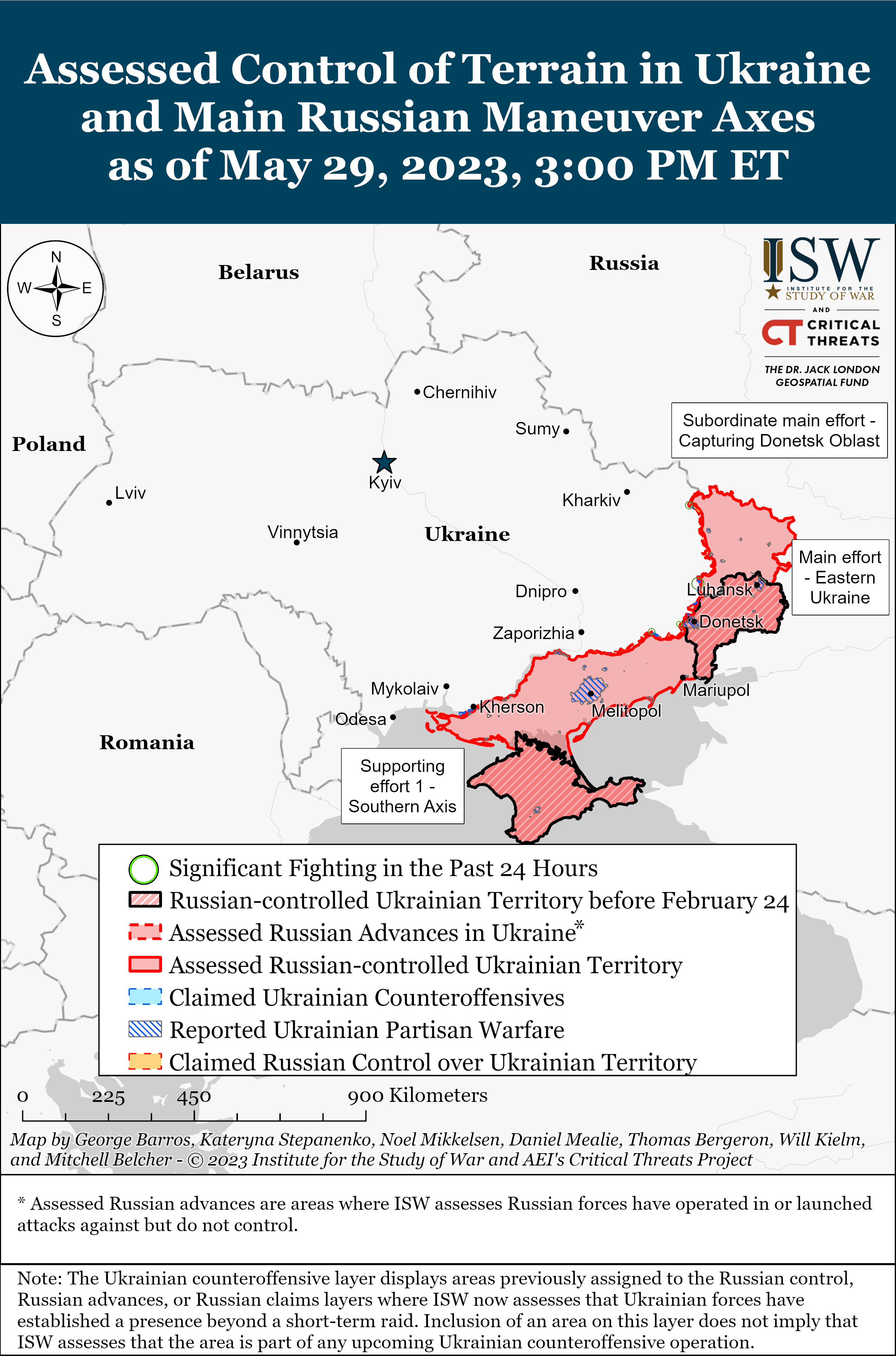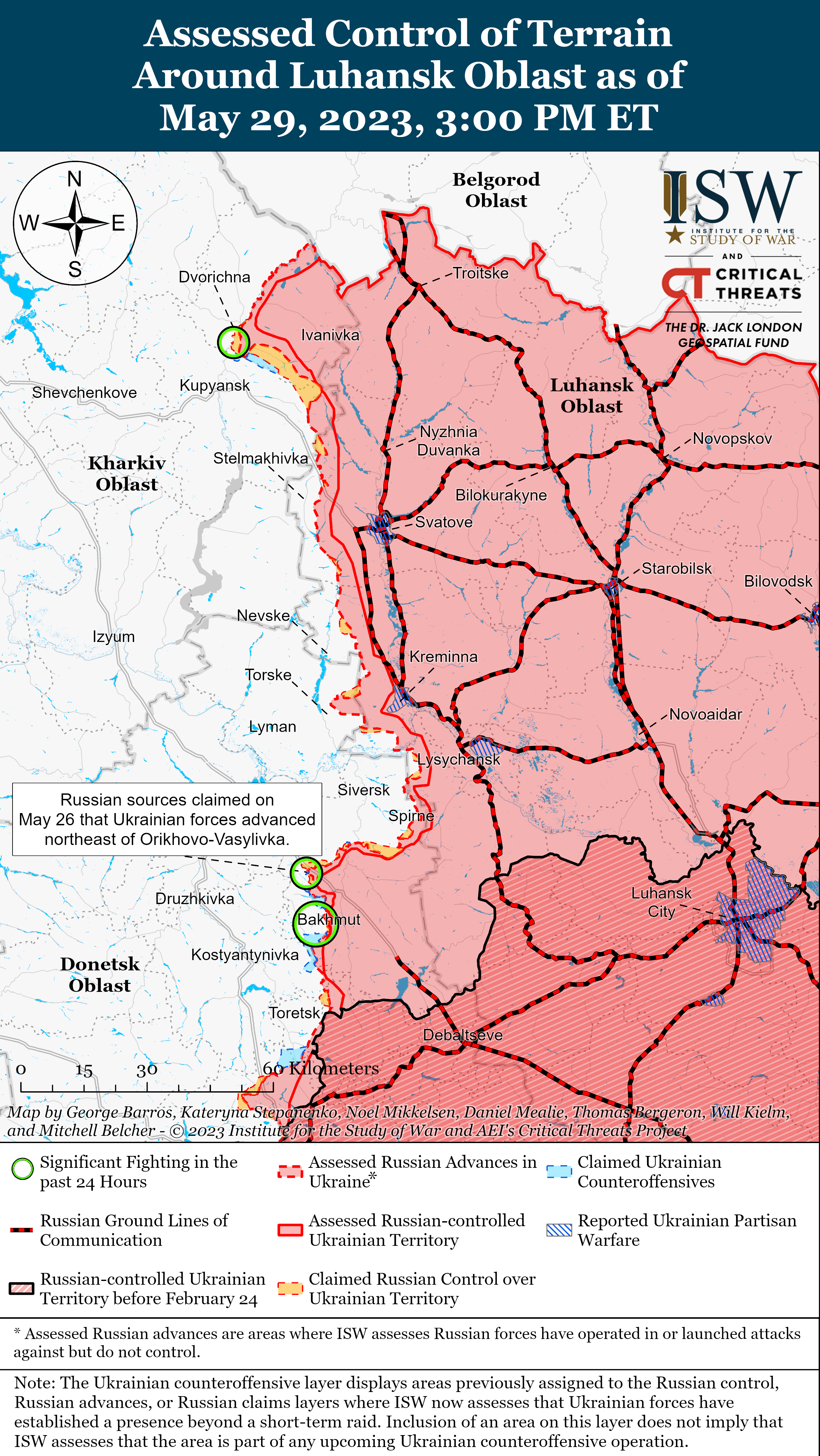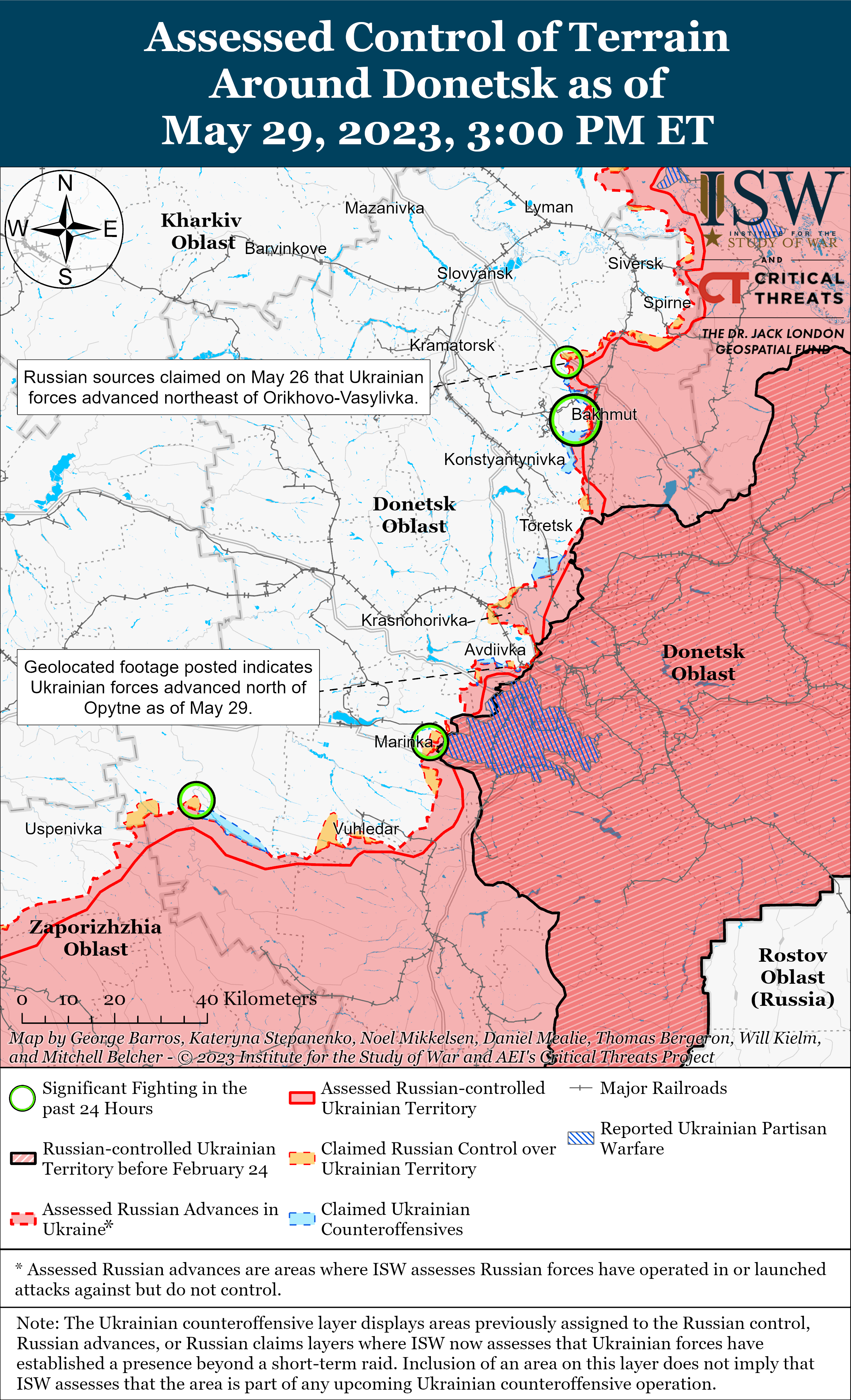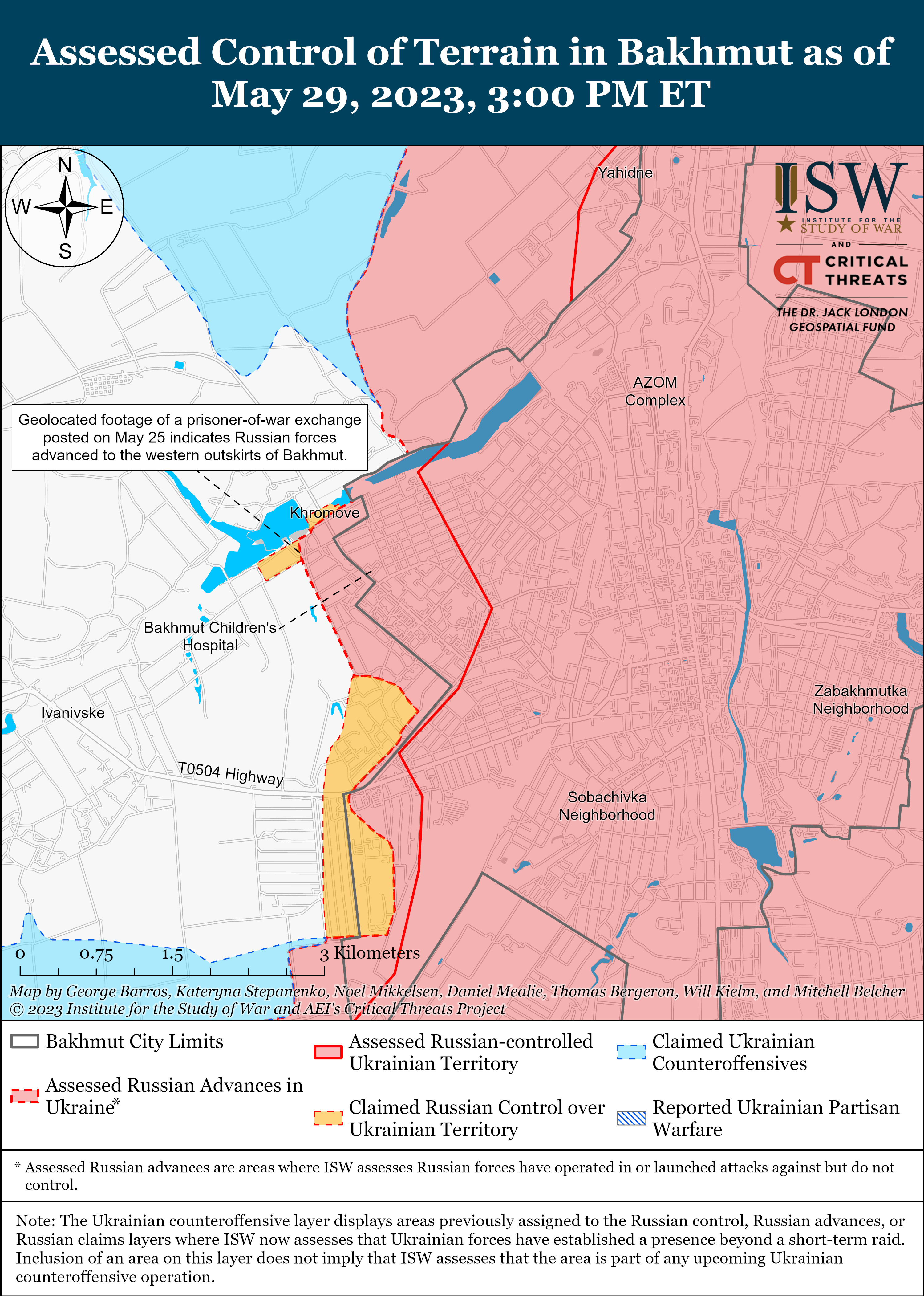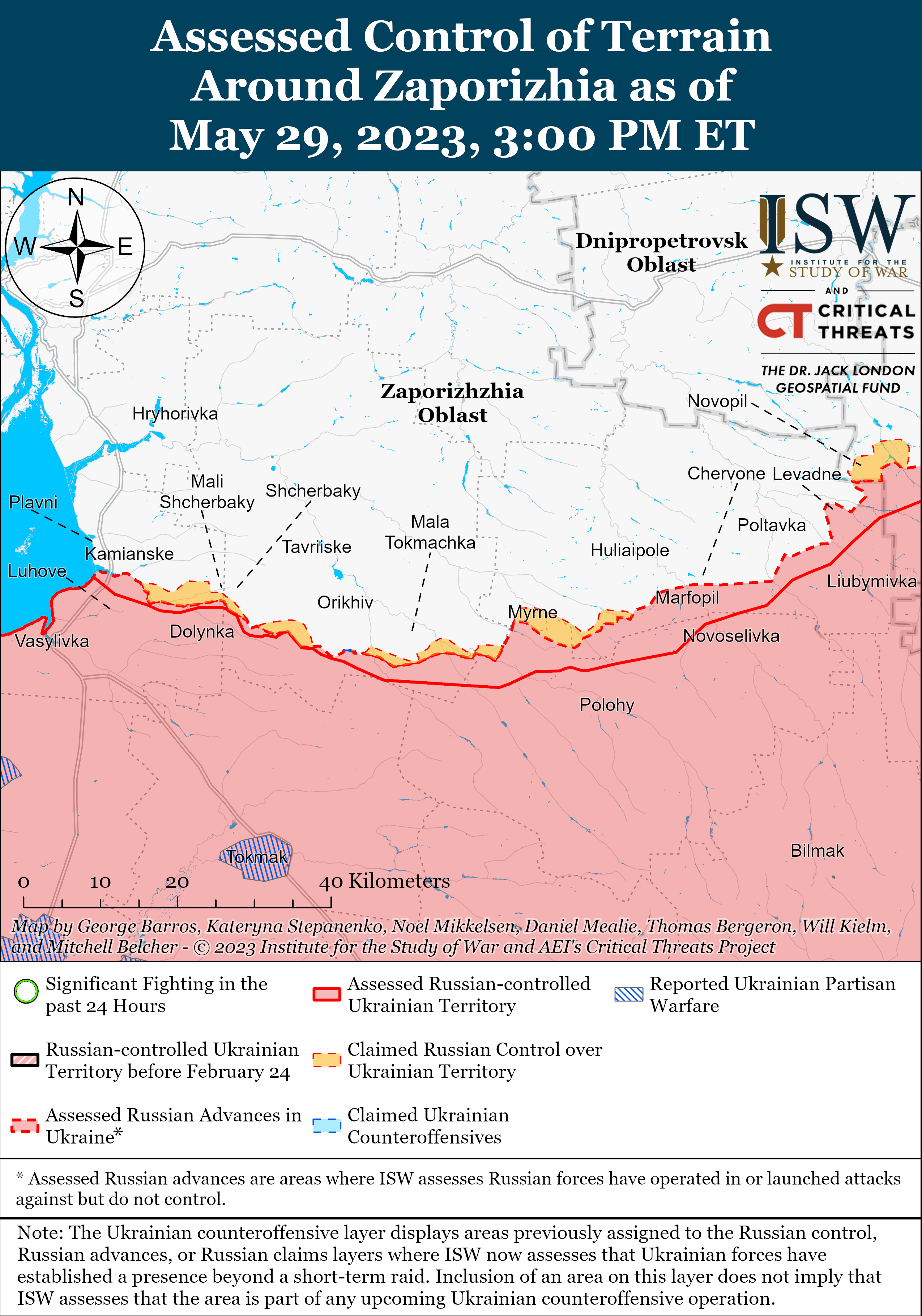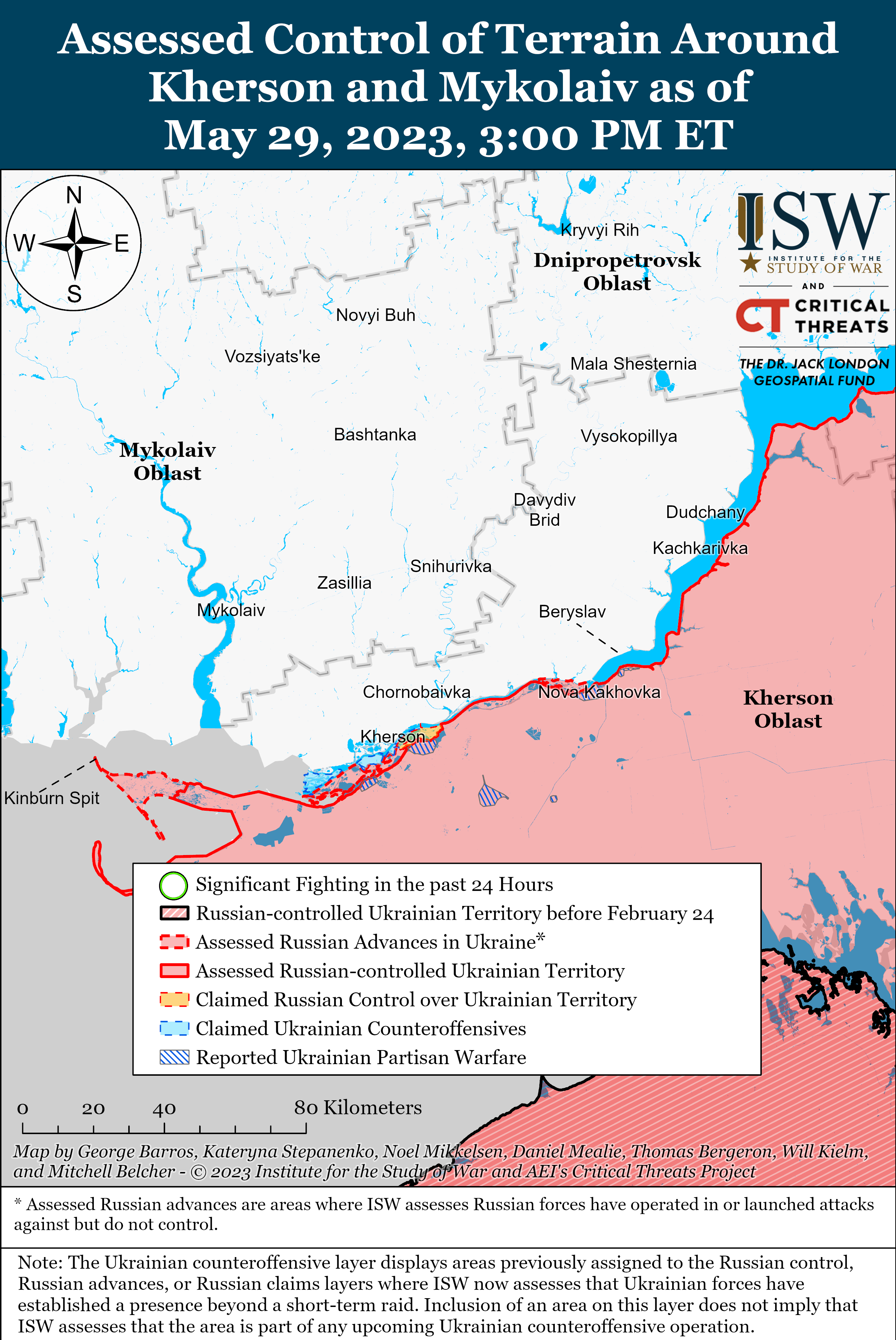Riley Bailey, Kateryna Stepanenko, Nicole Wolkov, George Barros, Karolina Hird, and Fredrick W. Kagan
May 29, 2023, 6:15pm ET
Click here to see ISW’s interactive map of the Russian invasion of Ukraine. This map is updated daily alongside the static maps present in this report.
Click here to access ISW’s archive of interactive time-lapse maps of the Russian invasion of Ukraine. These maps complement the static control-of-terrain map that ISW produces daily by showing a dynamic frontline. ISW will update this time-lapse map archive monthly.
Note: The data cutoff for this product was 1pm ET on May 29. ISW will cover subsequent reports in the May 30 Russian Offensive Campaign Assessment.
Russian forces conducted another series of strikes against Ukraine with cruise missiles and Iranian-made drones overnight on May 28 to 29 and during the day on May 29. The Ukrainian General Staff reported that Russian forces launched 40 Kh-101/Kh-555 air-based cruise missiles and 38 Shahed-131/136 drones on the night of May 28 to 29 and 11 Iskander-M/K missiles during the day on May 29.[1] The Ukrainian General Staff reported that Ukrainian air defenses destroyed in all 36 Kh-101/Kh-555 cruise missiles, 30 Shahed drones, and all 11 Iskander missiles.[2] Ukrainian officials reported that Ukrainian forces intercepted all 11 Iskander missiles, and 40 cruise missiles and Shahed drones that targeted Kyiv City and Kyiv Oblast.[3] Ukrainian sources reported that Ukrainian forces also intercepted missiles and drones near the cities of Lviv, Mykolaiv, and Odesa, and that Russian forces struck port infrastructure in Odesa City and a military infrastructure facility in Khmelnytskyi Oblast.[4] Russian forces launched a relatively higher number of missiles than in recent series of strikes following the largest Russian series of Shahed strikes since the start of the full-scale invasion of Ukraine on May 28.[5] ISW previously assessed that Russian forces began a new limited air campaign in recent months to degrade Ukrainian counteroffensive capabilities, but that the Russian prioritization of targeting Kyiv is likely further limiting the campaign’s ability to meaningfully constrain potential Ukrainian counteroffensive actions.[6]
Russia deployed more S-400 air defense systems (probably at least a battery) to Belarus on May 28. The Belarusian Ministry of Defense released video on May 28 showing a train with S-400 systems deploying to an unspecified area in Belarus.[7] Independent Belarusian monitoring organization The Hajun Project reported that the train with S-400s arrived at the 25th Missile Arsenal near Stoubtsi (about 60 km southwest of Minsk).[8] It is unclear whether these S-400s will enter service near Stoubtsi or deploy further to a different location. These systems will likely enter service with the Belarusian military but under Russian operational control. Russia’s and Belarus’ Joint Regional Air Defense System (established in 2009 and operational in 2016) effectively subordinates Belarus’ air defense assets to the Russian Western Military District.[9] Belarusian officials confirmed that Russian-provided S-400 in Belarus became operational and deployed on combat duty on December 25, 2022.[10] ISW forecasted in 2020 that Russia would deploy S-400s to Belarus.[11]
Former Russian Deputy Minister of Defense for Logistics Colonel General Mikhail Mizintsev confirmed that he is now operating as deputy commander of the Wagner Group. A Kremlin-affiliated milblogger published an interview on May 29 in which Mizintsev confirmed previous claims that he assumed the position.[12] Mizintsev stated that he has maintained good relations with Wagner for the previous 10 years, further substantiating reports that Wagner financier Yevgeny Prigozhin used close connections with Mizintsev to secure resources for Wagner while Mizintsev was in the Russian MoD.[13] Mizintsev claimed to be in Bakhmut overseeing the ongoing relief-in-place operation and claimed that Wagner is conducting an organized withdrawal.[14] Mizintsev praised the Wagner commanders and advocated that Wagner’s structure and management become a model for the total war that Russia needs to be fighting.[15] Mizintsev declined to comment about feuds between the Russian Ministry of Defense (MoD) and Wagner but highlighted that the Russian military has struggled with ammunition provisions and conducting a large-scale mobilization of the Russian nation to win in Ukraine.[16] ISW previously assessed that Prigozhin likely appointed Mizintsev as Wagner deputy commander in an effort to retain Wagner’s access to supplies, and Prigozhin has since promoted Mizintsev as his preferred replacement for Russian Defense Minister Sergei Shoigu.[17] Mizintsev’s publicized confirmation of his position and adulation of Wagner is likely part of Prigozhin’s wider effort to advocate for more influence following the capture of Bakhmut.[18]
Wagner Group financier Yevgeny Prigozhin denied former Russian officer Igor Girkin’s May 27 accusation that Prigozhin could stage a military coup against the Kremlin by arguing that Wagner lacks the personnel needed to start a coup. Prigozhin stated on May 29 that there are different types of coups across the globe – including a “chaotic military coup” in Sudan – which take too long and result in major conflicts.[19] Prigozhin argued that Wagner does not have a large enough army required to carry out a coup and claimed that Wagner has good relations with Russian President Vladimir Putin. Prigozhin vaguely implied that Russian Defense Minister Sergei Shoigu could stage a coup as he has access to the Russian Special Forces. Prigozhin added that while some individuals in Russia are expecting a revolution Wagner is only advocating for select corrections to the Russian system. Prigozhin’s response to Girkin notably follows his response to a media inquiry in which he hypothesizes about who could have authorized the reported ban on mentions of Wagner on the Russian state media, and even considered Putin.[20] Prigozhin then stated that there is an effort in Russia to avoid recognizing the legitimate heroes of this war and that “the officials-bureaucrats who run the Russian state today must remain the heroes and they are the only ones who can be thanked.” He added that “if they aren’t thanked, then they say, ‘Fine, heck with it, praise the president,’” implying that Putin is receiving unearned praise and thanks because of the unwillingness of Russian bureaucrats to honor those who truly deserve it. Prigozhin has dramatically increased the number of direct references to Putin since May 9 – after he indirectly criticized Putin during the Victory Day holiday.[21]
Chinese Foreign Ministry Spokesperson Mao Ning denied a Wall Street Journal report that Chinese Special Representative for Eurasian Affairs Li Hui urged European officials to end the conflict in Ukraine before it escalates.[22] Mao claimed that European officials acknowledged China’s “positive role in promoting peace talks” and appreciated China’s “calling for sovereignty and territorial integrity.”[23] Mao claimed that the war in Ukraine is “now at a critical juncture” and that China continues to attempt to work with all parties to resolve the “crisis.” Ukrainian Foreign Minister Dmytro Kuleba stated that European officials did not confirm reports that Li urged them attempt to end the war or consider recognizing Russian-occupied areas of Ukraine as Russian territory.[24] Kuleba also stated that Ukraine will continue to engage with China on the basis of three principles: mutual respect for territorial integrity, no proposals of territorial concessions, and no suggestions of freezing the conflict.
Russian authorities continue to forcefully integrate dioceses of the Ukrainian Orthodox Church of the Moscow Patriarchate (UOC MP) in occupied Zaporizhia Oblast into the Russian Orthodox Church (ROC) demonstrating the integral connection of the ROC with the Russian state. Zaporizhia Oblast occupation official Vladimir Rogov claimed that the Russian Bishop of Bronnitsky, Luka, held the first liturgy of the Russian Orthodox Church in Berdyansk Cathedral, which the Russian Orthodox Church had taken control over on May 16.[25] Rogov claimed that Russian Orthodox Church Head Patriarch Kirill appointed Bishop of Bronnitsky Luka as head of the Berdyansk and Prymorsk dioceses of the ROC. The Berdyansk and Prymorsk dioceses were previously part of the Russian-affiliated UOC MP, and their forced integration with the ROC emphasizes the close relationship between the ROC and the Russian state.[26]
Key Takeaways
- Russian forces conducted another series of strikes against Ukraine with cruise missiles and Iranian-made drones overnight on May 28 to 29 and during the day on May 29.
- Russia deployed more S-400 air defense systems (probably at least a battery) to Belarus on May 28.
- Former Russian Deputy Minister of Defense for Logistics Colonel General Mikhail Mizintsev confirmed that he is now operating as deputy commander of the Wagner Group.
- Wagner Group financier Yevgeny Prigozhin denied former Russian officer Igor Girkin’s May 27 accusation that Prigozhin could stage a military coup against the Kremlin by arguing that Wagner lacks the personnel needed to start a coup.
- Chinese Foreign Ministry Spokesperson Mao Ning denied a Wall Street Journal report that Chinese Special Representative for Eurasian Affairs Li Hui urged European officials to end the conflict in Ukraine before it escalates.
- Russian authorities continue to forcefully integrate dioceses of the Ukrainian Orthodox Church of the Moscow Patriarchate (UOC MP) in occupied Zaporizhia Oblast into the Russian Orthodox Church (ROC) demonstrating the integral connection of the ROC with the Russian state.
- Russian forces conducted limited ground attacks northeast of Kupyansk and along the Svatove-Kreminna line.
- The tempo of Russian offensive operations in and around Bakhmut remains notably low.
- Russian forces continued limited offensive operations along the Avdiivka-Donetsk City front, particularly focusing on Marinka.
- Russian forces conducted limited ground attacks in western Donetsk Oblast and are expanding fortifications in Mariupol.
- Russian sources claimed that Russian forces repelled limited Ukrainian reconnaissance in force operations in Zaporizhia Oblast.
- The Russian military command appears to be introducing doctrinal organization to some of its irregular formations.
- Russian President Vladimir Putin signed a law on May 29 that will further strengthen the martial law regime in occupied areas of Ukraine.
- Belarusian President Alexander Lukashenko is likely not hospitalized as of May 29.
We do not report in detail on Russian war crimes because these activities are well-covered in Western media and do not directly affect the military operations we are assessing and forecasting. We will continue to evaluate and report on the effects of these criminal activities on the Ukrainian military and the Ukrainian population and specifically on combat in Ukrainian urban areas. We utterly condemn these Russian violations of the laws of armed conflict, Geneva Conventions, and humanity even though we do not describe them in these reports.
- Russian Main Effort – Eastern Ukraine (comprised of two subordinate main efforts)
- Russian Subordinate Main Effort #1 – Capture the remainder of Luhansk Oblast and push westward into eastern Kharkiv Oblast and encircle northern Donetsk Oblast
- Russian Subordinate Main Effort #2 – Capture the entirety of Donetsk Oblast
- Russian Supporting Effort – Southern Axis
- Russian Mobilization and Force Generation Efforts
- Activities in Russian-occupied areas
Russian Main Effort – Eastern Ukraine
Russian Subordinate Main Effort #1 – Luhansk Oblast (Russian objective: Capture the remainder of Luhansk Oblast and push westward into eastern Kharkiv Oblast and northern Donetsk Oblast)
Russian forces conducted limited ground attacks northeast of Kupyansk and along the Svatove-Kreminna line on May 29. The Ukrainian General Staff reported that Russian forces conducted unsuccessful offensive operations near Masyutivka (13km northeast of Kupyansk) and did not conduct offensive operations in the Kreminna area.[27] Ukrainian Ground Forces Commander Colonel General Oleksandr Syrskyi reported that Ukrainian forces continue to repel all Russian attempted advances near Novoselivske (15km northwest of Svatove), Torske (14km west of Kreminna), Bilohorivka (10km south of Kreminna), and Spirne (25km south of Kreminna).[28] Russian milbloggers claimed that Russian forces advanced from Masyutivka, although ISW has still not seen visual confirmation of these advances nor confirmation that Russian forces control Masyutivka.[29] Russian milbloggers claimed that Russian forces advanced toward Bilohorivka from the northeast and are trying to encircle Ukrainian forces in the area.[30] ISW has not seen visual confirmation supporting a Russian advance near Bilohorivka. A pro-Kremlin milblogger claimed that Russian forces are preparing offensive operations to capture Siversk (17km southwest of Kreminna).[31] The Kreminna area is one of the few areas along the front line where Russian forces continue routine offensive operations, and Russian forces may be concentrating offensive capabilities in this area to set conditions for a potential offensive toward Siversk. A Russian milblogger claimed on May 8 that unspecified Russian airborne units and a Don Cossack special unit are operating in the Serebrianske forest area (10km south of Kreminna) and that Chechen Akhmat and 2nd Luhansk People’s Republic Army Corps elements are operating near Zolotarivka (16km south of Kreminna).[32]
Russian sources claimed that Ukrainian forces conducted a HIMARS strike on Almazna in Luhansk Oblast on May 28.[33] Geolocated footage published on May 28 showed the aftermath of the reported HIMARS strike on Almazna.[34]
Russian Subordinate Main Effort #2 – Donetsk Oblast (Russian Objective: Capture the entirety of Donetsk Oblast, the claimed territory of Russia’s proxies in Donbas)
Click here to read ISW’s new retrospective analysis on the Battle for Bakhmut.
The tempo of Russian offensive operations in and around Bakhmut remains notably low as of May 29. The Ukrainian General Staff reported that Russian forces conducted unsuccessful offensive operations northeast of Orikhovo-Vasylivka (11km northeast of Bakhmut) and in the direction of Ivanivske (6km west of Bakhmut).[35] The Ukrainian General Staff reported in its later situational report for May 29 that Russian forces did not conduct offensive operations in the Bakhmut direction.[36] Ukrainian Deputy Defense Minister Hanna Malyar reported that Russian forces are decreasing the tempo of their operations in the Bakhmut area amidst the ongoing Russian relief-in-place operation.[37] Malyar stated that Russian regular formations are continuing to assume control of Wagner’s positions in Bakhmut City itself as well as on the flanks around the city.[38] The Russian Ministry of Defense (MoD) confirmed on May 29 that elements of the 106th Guards Airborne Division are operating on the northern flanks of Bakhmut, likely in connection with the ongoing relief-in-place operation.[39] Malyar stated that Ukrainian forces retain positions on the southwestern outskirts of Bakhmut City and that Ukrainian forces did not attempt to advance in the Bakhmut area on May 28 and 29 in order to prioritize other unspecified tasks.[40] A Russian milblogger claimed that Ukrainian forces made unspecified gains in the direction of Klishchiivka (7km southwest of Bakhmut), and that Russian forces attacked near Khromove (immediately west of Bakhmut).[41]
Russian forces continued limited offensive operations along the Avdiivka-Donetsk City front on May 29, particularly around Marinka. The Ukrainian General Staff reported that Ukrainian forces repelled 12 Russian assaults near Marinka (27km southwest of Avdiivka), more than half of the Russian assaults along the entire front reported by the Ukrainian General Staff on May 29.[42] Ukrainian Tavriisk Defense Forces Spokesperson Valerii Shershen stated on May 28 that Russian forces are concentrating their efforts on the Avdiivka and Marinka areas, where Russian forces are reportedly attempting to seize Ukrainian platoon strongholds.[43] A Russian milblogger claimed on May 29 that Russian forces conducted assaults in the direction of Pervomaiske (11km southwest of Avdiivka) and Sieverne (6km west of Avdiivka).[44]
Russian forces conducted limited ground attacks in western Donetsk Oblast on May 29. The Ukrainian General Staff reported that Russian forces conducted unsuccessful offensive operations near Velyka Novosilka (55km southwest of Donetsk City).[45] A prominent Russian milblogger claimed on May 28 that positional battles occurred near Vuhledar (30km southwest of Donetsk City).[46]
Russian forces are reportedly expanding fortifications around Mariupol amidst continued Ukrainian strikes on Russian rear areas near the city. Ukrainian Mariupol Mayoral Advisor Petro Andryushchenko stated on May 29 that Russian forces have recently intensified construction of fortifications around Mariupol and are transporting logs into the city to construct dugouts.[47] Andryushchenko also stated that a Ukrainian strike on a Russian concentration area in the vicinity of Mariupol killed 100 Russian personnel and wounded 40 others on May 28.[48] Russian sources recently reported that Ukrainian forces conducted missile strikes against Mariupol on May 19 and 26.[49]
Russian Supporting Effort – Southern Axis (Russian objective: Maintain frontline positions and secure rear areas against Ukrainian strikes)
Russian forces continued defensive operations in southern Ukraine on May 29. Ukrainian Melitopol Mayor Ivan Fedorov reported that Russian forces continue to construct trenches on the outskirts of Melitopol in Zaporizhia Oblast that are large enough to accommodate “equipment and mass graves.”[50] Fedorov also reported that Russian forces are concealing equipment and manpower in the Bohatyr forest area near Melitopol but also using the trees to build fortifications.[51] ISW has previously reported on Russian forces building fortifications near Melitopol.[52]
Russian sources claimed that Russian forces repelled limited Ukrainian reconnaissance-in-force operations in southern Ukraine. Zaporizhia Oblast occupation official Vladimir Rogov claimed that Russian forces repelled a reconnaissance-in-force operation near Lobkove (37km southeast of Zaporizhzhia City) in Zaporizhia Oblast.[53] Chair of the Kherson Oblast occupation government Andrey Alekseyenko claimed that units of the 34th Mountain Brigade (49th Combined Arms Army, Southern Military District) are operating in the Dnipro River area.[54] Ukrainian Kherson Oblast Administration Advisor Serhiy Khlan reported on May 28 that unspecified Chechen troops operate on the part of the Arabat Spit in Kherson Oblast to guard against desertion.[55]
Russian Mobilization and Force Generation Efforts (Russian objective: Expand combat power without conducting general mobilization)
The Russian military command appears to be introducing doctrinal organization to some of its irregular formations. Servicemen of the 3rd Battalion of the 1307 Regiment of the 6th Division who had previously operated in the Soledar area recorded an appeal complaining about lack of adequate leadership and poor treatment of personnel on the battlefield.[56] Russian regular forces have not had a 6th Division after disbanding the 6th Guards Motorized Riffle Division in 1992, and the subordination of the regiment under a division likely indicates that Russian forces are attempting to regularize command and control in the irregular formations.[57]
Wagner Group financier Yevgeny Prigozhin continues to advocate for the creation of regional militias in Russian oblasts that border Ukraine. Prigozhin published a letter which he addressed to Russian Defense Minister Sergey Shoigu calling for the Russian Ministry of Defense (MoD) to create local self-defense units in response to recent sabotage activity on the Russian-Ukrainian border.[58] Prigozhin claimed that Russia needs 300 battalions (or 100 regiments) with a total of 198,000 personnel to protect the 540km border between Ukraine and Belgorod Oblast. Prigozhin also noted that Russia will not be able to adequately defend the border without mobilization and called on the Russian MoD to create the Belgorod Oblast mobilization reserve to be overseen by Wagner military advisers. Prigozhin also claimed that the formation of a 198,000-person territorial defense formation should be legal under the Russian constitution as it aims to protect Russia.[59]
Russian President Vladimir Putin signed a decree on May 29 to form a Presidium of the Collegium of the Military Industrial Commission, which will have the authority to make operational decisions aimed at ensuring the completion of military-industrial tasks.[60] The decree states that the authorized representatives in federal districts are required to ensure activities of different state officials to solve issues relating to the implementation of investment projects necessary for the production of military supplies. The decree also orders federal representatives to solve issues pertaining to labor shortages and to incentivize employees with social guarantees.
Chechen leader Ramzan Kadyrov alongside Chechen National Policy Minister Akhmed Dudayev and Commander of the Akhmat-Khadzhi Kadyrov Special Police Regiment Zamid Chalaev delivered military equipment and met with commanders of the Donetsk People’s Republic’s (DNR) on May 28.[61] Kadyrov also claimed to have visited Chechen “Akhmat” Special Forces headquarters in occupied Ukraine.[62] Kadyrov is likely attempting to present himself as an involved war-time figure following his meeting with Putin on May 20 during which he claimed that seven Chechen regiments and four Chechen battalion are operating in Ukraine.[63]
Russian occupation officials are continuing to form volunteer battalions in occupied Ukraine. A Ukrainian official stated that Kherson Oblast Occupation Head Vladimir Saldo announced that recruitment for the “Margelov” volunteer battalion in occupied Kherson Oblast is open for all Russian regions.[64] The Ukrainian military official noted that Saldo’s announcement indicates that Ukrainian locals in occupied Kherson Oblast are uninterested in supporting the Russian war effort.
A draft presidential decree suggests that the Kremlin intends to simplify the process of voluntary resettlement to Russia for compatriots living abroad.[65] The decree, if passed, will allow former Russian or Soviet citizens and those with direct lineage to Russia who lived abroad as of February 24, 2022 to resettle in Russia. The decree will offer exemption from customs duties, waive the language proficiency requirement, and provide compensation. The decree is likely part of an ongoing Russian attempt to counteract a population decline in Russia and to facilitate additional recruitment efforts.
Activities in Russian-occupied areas (Russian objective: Consolidate administrative control of annexed areas; forcibly integrate Ukrainian civilians into Russian sociocultural, economic, military, and governance systems)
Russian President Vladimir Putin signed a law on May 29 that will further strengthen the martial law regime in occupied areas of Ukraine.[66] As ISW previously reported, the Russian State Duma and Federation Council have approved the law, and the law will allow Russian occupation authorities to hold elections in areas under martial law, which was previously forbidden.[67] The law also codifies conditions for the removal and deportation of Ukrainians living in occupied areas to areas that are not under martial law.[68]
Russian occupation authorities continue repressions against Crimean Tatars and Tatar-affiliated groups. The Russian Federal Security Service (FSB) reported on May that it detained two Crimean residents on the charge of participating in the “Crimean Tatar Volunteer Battalion named after Noman Chelebidzikhan” (also known as the “Asker” Battalion), which Russia has classified as a “terrorist organization.”[69]
Significant activity in Belarus (ISW assesses that a Russian or Belarusian attack into northern Ukraine is extraordinarily unlikely).
Belarusian President Alexander Lukashenko is likely not hospitalized as of May 29. Lukashenko met with Russian Central Bank Governor Elvira Nabiullina in Minsk on May 29, dispelling previous unconfirmed reports that Lukashenko may have been hospitalized as of May 27 or 28.[70]
Belarusian and possibly Russian authorities are constructing field fortifications in Belarus. Satellite images taken on May 25 show dragons’ teeth vehicle traps and trenches on the M8 highway in Gomel Oblast, Belarus, about 20 kilometers from the Belarusian-Ukrainian border.[71] Russian authorities may seek to connect field fortifications in Belarus with the line of field fortifications that spans from Belgorod, Kursk, and Bryansk oblasts up to the Russian-Belarusian international border.
ISW will continue to report daily observed Russian and Belarusian military activity in Belarus, but these are not indicators that Russian and Belarusian forces are preparing for an imminent attack on Ukraine from Belarus. ISW will revise this text and its assessment if it observes any unambiguous indicators that Russia or Belarus is preparing to attack northern Ukraine.
Note: ISW does not receive any classified material from any source, uses only publicly available information, and draws extensively on Russian, Ukrainian, and Western reporting and social media as well as commercially available satellite imagery and other geospatial data as the basis for these reports. References to all sources used are provided in the endnotes of each update.
[1] https://www.facebook.com/GeneralStaff.ua/posts/pfbid03n8ofjJkwrF6rfaxTscUvQrKYZYQsBPLM9W5mdDgNMgxWCSzgFX43AGzYyQPE4Ppl ; https://www.facebook.com/GeneralStaff.ua/posts/pfbid02gnf9ni5nnAFocejsLZAd8T9ppvCCbJKdBft8TqPjj2noGEf1GhiVqcbEKggjZyfTl
[2] https://www.facebook.com/GeneralStaff.ua/posts/pfbid02gnf9ni5nnAFocejsLZAd8T9ppvCCbJKdBft8TqPjj2noGEf1GhiVqcbEKggjZyfTl ; https://www.facebook.com/GeneralStaff.ua/posts/pfbid03n8ofjJkwrF6rfaxTsc…
[4] https://t.me/khmelnytskaODA/1680 ; https://suspilne dot media/489895-460-den-vijni-onlajn/?anchor=live_1685341982&utm_source=copylink&utm_medium=ps ; https://www.facebook.com/OperationalCommandSouth/posts/pfbid021bZRXcfoXtQSoLbZLMZpb4SfNRSyH2cq179cm56FSE4JMVSaSYMnByMFivTW3b3Dl ; https://t.me/kozytskyy_maksym_official/8411
[6] https://understandingwar.org/backgrounder/russian-offensive-campaign-assessment-may-28-2023 ; https://isw.pub/UkrWar051423
[9] https://icds.ee/wp-content/uploads/2021/08/The-Belarusian-Armed-Forces.pdf; https://www.sb dot by/articles/pyat-voprosov-o-vazhnom.html; https://web.archive.org/web/20170814091843/https://www.mid.ru/foreign_po…
[11] https://understandingwar.org/backgrounder/belarus-warning-update-belarus-confirms-plans-purchase-advanced-air-defense-systems; https://understandingwar.org/backgrounder/belarus-warning-update-lukashenko-and-kremlin-vie-control-over-future-russian-weapons; https://understandingwar.org/backgrounder/russian-offensive-campaign-assessment-december-20; https://understandingwar.org/backgrounder/belarus-warning-update-luk…
[12] https://t.me/wargonzo/12837 ; https://dzen dot ru/video/watch/6474a4948dcfc23d8dcfcc2a?share_to=telegram&utm_referer=t.me
[13] https://dzen dot ru/video/watch/6474a4948dcfc23d8dcfcc2a?share_to=telegram&utm_referer=t.me ; https://t.me/wargonzo/12837 ; https://isw.pub/UkrWar050523
[14] https://dzen dot ru/video/watch/6474a4948dcfc23d8dcfcc2a?share_to=telegram&utm_referer=t.me ;
[15] https://dzen dot ru/video/watch/6474a4948dcfc23d8dcfcc2a?share_to=telegram&utm_referer=t.me ; https://t.me/wargonzo/12837
[16] https://dzen dot ru/video/watch/6474a4948dcfc23d8dcfcc2a?share_to=telegram&utm_referer=t.me ; https://t.me/wargonzo/12837
[22] https://www.wsj.com/articles/china-pushing-ukraine-cease-fire-gets-cool-reception-in-europe-614774dd; https://understandingwar.org/backgrounder/russian-offensive-campaign-assessment-may-26-2023
[24] https://www.pravda.com dot ua/news/2023/05/27/7404154/
[27] https://www.facebook.com/GeneralStaff.ua/posts/pfbid03n8ofjJkwrF6rfaxTscUvQrKYZYQsBPLM9W5mdDgNMgxWCSzgFX43AGzYyQPE4Ppl; https://www.facebook.com/GeneralStaff.ua/posts/pfbid02gnf9ni5nnAFocejsLZAd8T9ppvCCbJKdBft8TqPjj2noGEf1GhiVqcbEKggjZyfTl
[33] https://t.me/kommunist/17500; https://t.me/miroshnik_r/11575; https://t.me/NeoficialniyBeZsonoV/25857; https://t.me/glava_lnr_info/1218; https://t.me/rybar/47710; https://t.me/rybar/47709; https://t.me/LPR_JCCC/8335 ; https://t.me/LPR_JCCC/8341 ; https://twitter.com/neonhandrail/status/1663182336232660995?s=20
[34] https://t.me/LPR_JCCC/8335 ; https://t.me/LPR_JCCC/8341 ; https://twitter.com/neonhandrail/status/1663182336232660995?s=20
[35] https://www.facebook.com/GeneralStaff.ua/posts/pfbid02gnf9ni5nnAFocejsLZAd8T9ppvCCbJKdBft8TqPjj2noGEf1GhiVqcbEKggjZyfTl
[36] https://www.facebook.com/GeneralStaff.ua/posts/pfbid03n8ofjJkwrF6rfaxTscUvQrKYZYQsBPLM9W5mdDgNMgxWCSzgFX43AGzYyQPE4Ppl ; https://www.facebook.com/GeneralStaff.ua/posts/pfbid02gnf9ni5nnAFocejsLZAd8T9ppvCCbJKdBft8TqPjj2noGEf1GhiVqcbEKggjZyfTl
[42] https://www.facebook.com/GeneralStaff.ua/posts/pfbid03n8ofjJkwrF6rfaxTscUvQrKYZYQsBPLM9W5mdDgNMgxWCSzgFX43AGzYyQPE4Ppl ; https://www.facebook.com/GeneralStaff.ua/posts/pfbid02gnf9ni5nnAFocejsLZAd8T9ppvCCbJKdBft8TqPjj2noGEf1GhiVqcbEKggjZyfTl
[43] https://suspilne dot media/489721-rf-zoseredila-osnovni-zusilla-na-dvoh-shidnih-napramkah-recnik-sil-oboroni-sersen/
[45] https://www.facebook.com/GeneralStaff.ua/posts/pfbid02gnf9ni5nnAFocejsLZAd8T9ppvCCbJKdBft8TqPjj2noGEf1GhiVqcbEKggjZyfTl
[48] https://t.me/andriyshTime/10229; https://t.me/andriyshTime/10204; https://t.me/andriyshTime/10202; https://t.me/andriyshTime/10201
[49] https://understandingwar.org/backgrounder/russian-offensive-campaign-assessment-may-21-2023 ; https://understandingwar.org/backgrounder/russian-offensive-campaign-assessment-may-27-2023
[52] https://understandingwar.org/backgrounder/russian-offensive-campaign-assessment-march-16-2023; https://understandingwar.org/backgrounder/russian-offensive-campaign-assessment-january-9-2023
[57] http://www.ww2 dot dk/new/army/td/90gvtd.htm
[60] https://www.vedomosti dot ru/technology/news/2023/05/29/977491-putin-obrazoval-prezidium-voenno-promishlennoi-komissii
[64] https://www.facebook.com/sergey.khlan/posts/pfbid0uHVCw3A9oD2nCy7DVP1f3o28CwpwpJThCQH5e6ASPsZKSPt7p2ZAVbdbHNzYsq7yl
[65] https://t.me/sotaproject/59831; https://regulation dot gov.ru/Regulation/Npa/PublicView?npaID=138671
[66] https://t.me/astrapress/28230; http://publication dot pravo.gov.ru/document/0001202305290002?pageSize=10&index=1
[68] https://t.me/astrapress/28230; http://publication dot pravo.gov.ru/document/0001202305290002?pageSize=10&index=1
[69] https://crimea.ria dot ru/20230529/pogranichniki-zaderzhali-v-krymu-dvukh-boevikov-ukrainskogo-natsbata-1129052820.html
[70] https://president.gov dot by/en/events/vstrecha-s-predsedatelem-centralnogo-banka-rossii-elviroy-nabiullinoy-1685356493; https://understandingwar.org/backgrounder/russian-offensive-campaign-ass…
